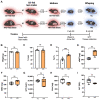Thermoneutral Housing Enables Studies of Vertical Transmission of Obesogenic Diet-Driven Metabolic Diseases
- PMID: 38068816
- PMCID: PMC10708424
- DOI: 10.3390/nu15234958
Thermoneutral Housing Enables Studies of Vertical Transmission of Obesogenic Diet-Driven Metabolic Diseases
Abstract
Vertical transmission of obesity is a critical contributor to the unabated obesity pandemic and the associated surge in metabolic diseases. Existing experimental models insufficiently recapitulate "human-like" obesity phenotypes, limiting the discovery of how severe obesity in pregnancy instructs vertical transmission of obesity. Here, via utility of thermoneutral housing and obesogenic diet feeding coupled to syngeneic mating of WT obese female and lean male mice on a C57BL/6 background, we present a tractable, more "human-like" approach to specifically investigate how maternal obesity contributes to offspring health. Using this model, we found that maternal obesity decreased neonatal survival, increased offspring adiposity, and accelerated offspring predisposition to obesity and metabolic disease. We also show that severe maternal obesity was sufficient to skew offspring microbiome and create a proinflammatory gestational environment that correlated with inflammatory changes in the offspring in utero and adulthood. Analysis of a human birth cohort study of mothers with and without obesity and their infants was consistent with mouse study findings of maternal inflammation and offspring weight gain propensity. Together, our results show that dietary induction of obesity in female mice coupled to thermoneutral housing can be used for future mechanistic interrogations of obesity and metabolic disease in pregnancy and vertical transmission of pathogenic traits.
Keywords: amniotic fluid; developmental origin of health and disease (DOHaD); high-fat diet; inflammation; intrauterine programming; metabolic dysfunction-associated steatotic liver disease (MASLD); pregnancy; stillbirth; type 2 diabetes.
Conflict of interest statement
The authors declare no conflict of interest.
Figures






References
-
- Engin A. The Definition and Prevalence of Obesity and Metabolic Syndrome. In: Engin A.B., Engin A., editors. Obesity and Lipotoxicity. Springer International Publishing; Cham, Switzerland: 2017. pp. 1–17.
-
- Lawlor D.A., Smith G.D., O’Callaghan M., Alati R., Mamun A.A., Williams G.M., Najman J.M. Epidemiologic evidence for the fetal overnutrition hypothesis: Findings from the mater-university study of pregnancy and its outcomes. Am. J. Epidemiol. 2007;165:418–424. doi: 10.1093/aje/kwk030. - DOI - PubMed
MeSH terms
Grants and funding
LinkOut - more resources
Full Text Sources
Medical

